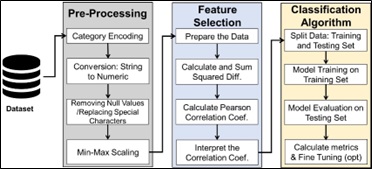ML-Driven Lightweight Botnet Detection System for IoT-Networks
Keywords:
Internet of Things (IoT), Intrusion Detection System (IDS), Machine Learning (ML), Feature Selection Algorithm, Botnet Detection.Abstract
The integration of cloud computing with the Internet of Things (IoT) seeks to create seamless connections between humans and devices, enhancing applications in areas like smart healthcare and home automation. However, this also brings significant security challenges. Our study addresses the critical need for an efficient anomaly detection system specifically designed for IoT-enabled cloud computing environments, a gap not previously explored at this scale. Utilizing the IoT-23 dataset, we evaluated various feature selection techniques in conjunction with classification algorithms to develop a lightweight anomaly detection model. Our results demonstrate that the decision tree classifier, paired with the correlation coefficient method for feature selection, achieved an impressive 99.98% accuracy rate, with an average processing time of just 5.2 seconds. This combination proved to be the most effective for real-time anomaly detection, presenting a promising approach for ensuring robust security in IoT networks as connectivity continues to grow.
References
Wang, H.; Ning, H.; Lin, Y.; Wang, W.; Dhelim, S.; Farha, F.; Ding, J.; Daneshmand, M. A Survey on the Metaverse: The State-of-the-Art, Technologies, Applications, and Challenges. IEEE Internet of Things Journal 2023, Vol 10, pp. 14671–14688.
Farooqi, A.H.; Akhtar, S.; Rahman, H.; Sadiq, T.; Abbass, W. Enhancing Network Intrusion Detection Using an Ensemble Voting Classifier for Internet of Things. Sensors 2024, 24, 127. https://doi.org/10.3390/s24010127
Wang, Y.; Su, Z.; Zhang, N.; Xing, R.; Liu, D.; Luan, T.H.; Shen, X. A Survey on Metaverse: Fundamentals, Security, and Privacy. IEEE Communications Surveys Tutorials 2023, Vol 25, pp. 319–352. http://doi:10.1109/COMST.2022.3202047
Kang, G.; Koo, J.; Kim, Y.G. Security and Privacy Requirements for the Metaverse: A Metaverse Applications Perspective. IEEE Communications Magazine 2023, pp. 1–7.
Dhiman, P.; Saini, N.; Gulzar, Y.; Turaev, S.; Kaur, A.; Nisa, K.U.; Hamid, Y. A Review and Comparative Analysis of Relevant Approaches of Zero Trust Network Model. Sensors 2024, 24, 1328. https://doi.org/10.3390/s24041328
Alam, T. Blockchain-Based Internet of Things: Review, Current Trends, Applications, and Future Challenges. Computers 2023, 12. http://doi:10.3390/computers12010006
Shwe, T.; Aritsugi, M. Optimizing Data Processing: A Comparative Study of Big Data Platforms in Edge, Fog, and Cloud Layers. Applied Sciences. 2024, 14, 452. https://doi.org/10.3390/app14010452
Sattari, F.; Farooqi, A.H.; Qadir, Z.; Raza, B.; Nazari, H.; Almutiry, M. A Hybrid Deep Learning Approach for Bottleneck Detection in IoT. IEEE Access 2022, Vol. 10, pp. 77039–77053. https://10.1109/ACCESS.2022.3188635
Sebastian Garcia, Agustin Parmisano, “IoT-23: A labeled dataset with malicious and benign IoT network traffic”. Zenodo 2020.
Alani, M.M.; Miri, A. Towards an Explainable Universal Feature Set for IoT Intrusion Detection. Sensors 2022, Vol. 22. https://doi:10.3390/s22155690
Li, J., Othman, M.S., Chen, H. et al. Optimizing IoT intrusion detection system: feature selection versus feature extraction in machine learning. J Big Data 2024, Vo. 11, 36. https://doi.org/10.1186/s40537-024-00892-y
Khan, F.A., Farooqi, A.H. & Derhab, A. A comprehensive security analysis of LEACH++ clustering protocol for wireless sensor networks. Journal of Supercomputing 2019, 75, 2221–2242. https://doi.org/10.1007/s11227-018-2680-3
Khan R, Tariq N, Ashraf M, Khan FA, Shafi S, Ali A. FL-DSFA: Securing RPL-Based IoT Networks against Selective Forwarding Attacks Using Federated Learning. Sensors. 2024; 24(17):5834. https://doi.org/10.3390/s24175834
Lin, J.; Yu, W.; Zhang, N.; Yang, X.; Zhang, H.; Zhao, W. A Survey on Internet of Things: Architecture, Enabling Technologies, Security and Privacy, and Applications. IEEE Internet of Things Journal 2017, 4, 1125–1142. https://doi:10.1109/JIOT.2017.2683200
Panza, M.A.; Pota, M.; Esposito, M. Anomaly Detection Methods for Industrial Applications: A Comparative Study. Electronics 2023, Vol 12.
Park, C.; Lee, J.; Kim, Y.; Park, J.G.; Kim, H.; Hong, D. An Enhanced AI-Based Network Intrusion Detection System Using Generative Adversarial Networks. IEEE Internet of Things Journal 2023, Vol. 10, 2330–2345. https://doi:10.1109/JIOT.2022.3211346
Benkhelifa, E.; Welsh, T.; Hamouda, W. A critical review of practices and challenges in intrusion detection systems for IoT: Toward universal and resilient systems. IEEE Communications Surveys & Tutorials 2018, Vol. 20, 3496–3509.
Pajouh, H.; Javidan, R.; Khayami, R.; Dehghantanha, A.; Choo, K. A Two-Layer Dimension Reduction and Two-Tier Classification Model for Anomaly-Based Intrusion Detection in IoT Backbone Networks. IEEE Transactions on Emerging Topics in Computing 2019, 7, 314–323. https://doi:10.1109/TETC.2016.2633228
Rabhi, S.; Abbes, T.; Zarai, F. “IoT botnet detection using deep learning.” 2023 International Wireless Communications and Mobile Computing, 2023, pp. 1107–1111.
Caldas Filho, F.L.; Soares, S.C.M.; Oroski, E.; de Oliveira Albuquerque, R.; da Mata, R.Z.A.; de Mendonça, F.L.L.; de Sousa Júnior, R.T. Botnet Detection and Mitigation Model for IoT Networks Using Federated Learning. Sensors 2023, Vol. 23. pp. 1-21.
Alosaimi, S.; Almutairi, S.M. An Intrusion Detection System Using BoT-IoT. Applied Sciences 2023, Vol. 13, 9: 5427. https://doi:10.3390/app13095427
Gromov, M.; Arnold, D.; Saniie, J. Utilizing Computer Vision Algorithms to Detect and Classify Cyberattacks in IoT Environments in Real-Time. 2023 IEEE International Conference on Electro Information Technology, 2023, pp. 300–303.
Li, J.; Zhao Z.; Li, R.; Zhang, H., "AI-Based Two-Stage Intrusion Detection for Software Defined IoT Networks," in IEEE Internet of Things Journal 2019, Vol. 6, 2, pp. 2093-2102. https://doi:10.1109/JIOT.2018.2883344
Latif, S.; Huma, Z.e.; Jamal, S.S.; Ahmed, F.; Ahmad, J.; Zahid, A.; Dashtipour, K.; Aftab, M.U.; Ahmad, M.; Abbasi, Q.H. Intrusion Detection Framework for the Internet of Things Using a Dense Random Neural Network. IEEE Transactions on Industrial Informatics 2022, Vol. 18, 6435–6444. https://doi:10.1109/TII.2021.3130248
Kamaldeep; Malik, M.; Dutta, M.; Granjal, J. IoT-Sentry: A Cross-Layer-Based Intrusion Detection System in Standardized Internet of Things. IEEE Sensors Journal 2021, Vol. 21, 24, pp. 28066-28076. https://doi:10.1109/JSEN.2021.3124886
Jeelani, F.; Rai, D.S.; Maithani, A.; Gupta, S. The Detection of IoT Botnet using Machine Learning on IoT-23 Dataset. 2nd International Conference on Innovative Practices in Technology and Management, Gautam Buddha Nagar, India, 2022, pp. 634-639, https://doi:10.1109/ICIPTM54933.2022.9754187

Downloads
Published
How to Cite
Issue
Section
License
Copyright (c) 2024 50sea

This work is licensed under a Creative Commons Attribution 4.0 International License.




















